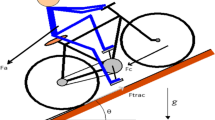Abstract
In this study, a method to reduce the torque ripple of brushless direct current (BLDC) traction motor which drives the electric wheelchair is discussed. As the main users of electric wheelchair are mobility handicapped people, it is important to decrease the speed ripple of the wheelchair for their comfort and safety and for this, reducing the torque ripple of traction motor can be a solution for this problem, because the fluctuation of vehicle speed is affected by ripple of the driving torque, especially at lower speed. The waveforms of current and back electromotive force (EMF) of motor need to be considered because they determine the torque characteristics such as average value and ripple. After the current waveform of BLDC motor is calculated by simulation, back EMF waveform that reduces the torque ripple is determined as a trapezoidal form. The traction motor for electric wheelchair reducing torque ripple is designed by optimization process. The design parameter selected from the sensitivity analysis are optimized through kriging surrogate model. Finally, the back EMF waveform and the torque ripple of BLDC motor are verified by conducting experiments.
















Similar content being viewed by others
Change history
28 September 2021
Due to an unfortunate oversight during the correction process the name of the second author in the biography section has been given erroneously.
References
Seki H, Ishihara K, Tadakuma S (2009) Novel regenerative braking control of electric power-assisted wheelchair for safety downhill road driving. IEEE Trans Ind Electron 56(5):1393–1400
Seki H, Tanohata N (2012) Fuzzy control for electric power-assisted wheelchair driving on disturbance roads. IEEE Trans Syst Man Cybern C Appl Rev 42(6):1624–1632
Wu BF, Chen YS, Huang CW, Chang PJ (2018) An uphill safety controller with deep learning-based ramp detection for intelligent wheelchairs. IEEE Access 6:28356–28371
Jang G, Kim J, Lee S, Choi Y (2016) EMG-based continuous control scheme with simple classifier for electric-powered wheelchair. IEEE Trans Ind Electron 63(6):3695–3705
Shibata T, Murakami T (2012) Power-assist control of pushing task by repulsive compliance control in electric wheelchair. IEEE Trans Ind Electron 59(1):511–520
Yang YP, Huang WC, Lai CW (2017) Optimal design of rim motor for electric powered wheelchair. IET Electr Power App 1(5):825–832
Rules for users of powered wheelchairs and mobility scooters (36 to 46),” Aug. 20, 2019. Accessed on : Sept. 11, 2019. [Online]. Available: https://www.gov.uk/guidance/the-highway-code/rules-for-users-of-powered-wheelchairs-and-mobility-scooters-36-to-46
Products-robo3.com (2019) Accessed on: Sept. 11, 2019. [Online]. Available: https://www.robo3.com/products/
Chen CH, Cheng MY (2007) A new cost effective sensorless commutation method for brushless DC motors without phase shift circuit and neutral voltage. IEEE Trans Power Electron 22(2):644–653
“Orthogonal Arrays,” Jan. 29, 2019. Accessed on: Oct. 24, 2020. [Online]. Available: http://neilsloane.com/oadir/
Montgomery DC (2017) Simple comparative experiments. In: Design and analysis of experiments, vol 2, 9th ed., John Wiley & Sons, New York, pp 35
Cho GW, Jang WS, Jang KB, Kim GT (2012) The optimal design of fractional-slot SPM to reduce cogging torque and vibration. JEET 7(5):753–758
Azar Z, Zhu ZH, Ombach G (2012) Investigation of torque-speed characteristics and cogging torque of fractional-slot IPM brushless AC machines having alternate slot openings. IEEE Trans Ind Appl 48(3):903–912
Fei W, Zhu ZQ (2013) Comparison of cogging torque reduction in permanent magnet brushless machines by conventional and herringbone skewing techniques. IEEE Trans Energy Convers 28(3):664–674
Lebensztajn L, Marretto CAR, Costa MC, Coulomb JL (2004) Kriging: a useful tool for electromagnetic device optimization. IEEE Trans Magn 40(2):1196–1199
Sacks J, Welch WJ, Mitchell TJ, Wynn HP (1989) Design and analysis of computer experiments. J Stat Sci 40(4):409–423
Kim S, Lee SG, Kim JM, Lee TH, Lim MS (2020) Uncertainty identification method using kriging surrogate model and Akaike information criterion for industrial electromagnetic device. IET Sci Meas Technol 14(3):250–258
Lee TH, Jung JJ (2007) “Kriging meta model based optimization”, in Optimization of structural and mechanical systems, vol 16. World Scientific Publishing Co., Singapore, pp 445–484
Queipo NV, Haftka RT, Shyy W, Goel T, Vaidyanathan R, Tucker PK (2005) Surrogate-based analysis and optimization. Prog Aerospace Sci 41(1):1–8
Acknowledgements
This work was supported by the National Research Foundation of Korea (NRF) grant funded by the Korea government (MSIT) (NRF-2020R1A4A4079701).
Author information
Authors and Affiliations
Corresponding author
Additional information
Publisher's Note
Springer Nature remains neutral with regard to jurisdictional claims in published maps and institutional affiliations.
Rights and permissions
About this article
Cite this article
Kim, DK., Kim, DM., Park, JC. et al. Torque Ripple Reduction of BLDC Traction Motor of Electric Wheelchair for Ride Comfort Improvement. J. Electr. Eng. Technol. 17, 351–360 (2022). https://doi.org/10.1007/s42835-021-00875-6
Received:
Revised:
Accepted:
Published:
Issue Date:
DOI: https://doi.org/10.1007/s42835-021-00875-6




